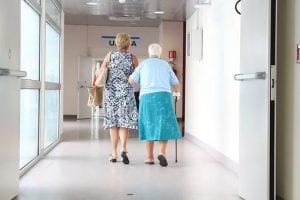Written by Joyce Smith, BS. Study reveals that among treated hypertensive patients, both minimum and mean systolic blood pressures of less than 110 mmHg were associated with serious falls and syncope.
 Approximately 46% of the general population (more than 100 million adults in the United States) have hypertension (HTN), as defined by the American Heart Association/American College of Cardiology 1. More aggressive steps for blood pressure (BP) control carry substantial risk 2,3 such as falls within the elderly population that can add cost to an already overburdened healthcare system 4. Studies have shown that 30% of the elderly population (aged 65 years or more) suffer at least one fall annually and more frequent falls when systolic blood pressure (SBP) is lower 5. In fact, falls among the elderly are one of the most common causes of injury-related hospital admissions. They are the leading cause of injury-related death, and are a strong predictor for skilled nursing home admission 4,6.
Approximately 46% of the general population (more than 100 million adults in the United States) have hypertension (HTN), as defined by the American Heart Association/American College of Cardiology 1. More aggressive steps for blood pressure (BP) control carry substantial risk 2,3 such as falls within the elderly population that can add cost to an already overburdened healthcare system 4. Studies have shown that 30% of the elderly population (aged 65 years or more) suffer at least one fall annually and more frequent falls when systolic blood pressure (SBP) is lower 5. In fact, falls among the elderly are one of the most common causes of injury-related hospital admissions. They are the leading cause of injury-related death, and are a strong predictor for skilled nursing home admission 4,6.
A current study 7 was conducted to determine whether aggressive HTN treatment similar to AHA/ACC recommended guidelines may have unintended adverse consequences such as falls and syncope (fainting) for patients with high BP. The health records of 477,516 individuals (mean age 65; 53% women) who were actively treated for HTN during a one-year observation period were analyzed. The lowest measured blood pressure reading within the observation period became the minimum SBP and the mean value of all blood pressure readings during the observation period determined the mean SBP. The study population had an overall mean BP of 129/72 mm HG. Seventy-five percent of participants had three or more BP reading during the observation period; 36 % were taking three or more antihypertensive drugs; 21 % had three or more comorbidities.
During the observation period, the following results were observed:
- 127,581 of study participants (7 %) had at least one SBP measurement of less than 110 mm Hg; 14,724 participants (3.1 %) had a mean SBP of less than 110 mm Hg.; and 15,419 (3.2 %) experienced a serious fall, fainted, or both.
- 7 % of those with a minimum SBP of less than 110 mm Hg experienced a serious fall or syncope compared with 2.3 % of those with a minimum SPB of 110 mm Hg or higher.
- 4 percent of those with a mean SBP of less than 110 mm Hg experienced a serious fall or syncope compared with 3.2 percent of those with a mean SBP of 110 mm Hg or higher.
- Compared to those with SBP greater than 110 mmHg, those with a minimum SBP and mean SBP of less than 110 mmHg, the multivariable odds (ORs) for serious falls and syncope were 2.18 (95% =2.11, 2.25) and 1.54 (95%CI=1.43, 1.66) respectively.
- Women, non-whites, patients with dementia, diabetes mellitus, and those taking three or more antihypertensive medications were more likely to experience a serious fall or fainting.
These findings suggest that in the current HTN treatment environment frequent BP monitoring and low BP thresholds for medication modification should be considered. This study showed that attaining a lower blood pressure could create a subpopulation of patients with very low blood pressure that might increase the risk of serious falls and fainting. Therefore, with the growing emphasis on intensive BP control and when individualizing HTN treatment, adverse treatment risk and treatment among high-risk populations should be important concerns.
Source: Sim, John J., Hui Zhou, Simran Bhandari, Rong Wei, Jeff W. Brettler, Jocelyn Tran-Nguyen, Joel Handler, Daichi Shimbo, Steven J. Jacobsen, and Kristi Reynolds. “Low systolic blood pressure from treatment and association with serious falls/syncope.” American journal of preventive medicine 55, no. 4 (2018): 488-496.
© 2018 American Journal of Preventive Medicine. Published by Elsevier
Posted January 6, 2020.
Joyce Smith, BS, is a degreed laboratory technologist. She received her bachelor of arts with a major in Chemistry and a minor in Biology from the University of Saskatchewan and her internship through the University of Saskatchewan College of Medicine and the Royal University Hospital in Saskatoon, Saskatchewan. She currently resides in Bloomingdale, IL.
References:
- Whelton PK, Carey RM, Aronow WS, et al. 2017 ACC/AHA/AAPA/ABC/ACPM/AGS/APhA/ASH/ASPC/NMA/PCNA Guideline for the Prevention, Detection, Evaluation, and Management of High Blood Pressure in Adults: Executive Summary: A Report of the American College of Cardiology/American Heart Association Task Force on Clinical Practice Guidelines. Hypertension. 2018;71(6):1269-1324.
- Wright JT, Jr., Williamson JD, Whelton PK, et al. A Randomized Trial of Intensive versus Standard Blood-Pressure Control. The New England journal of medicine. 2015;373(22):2103-2116.
- Benetos A, Labat C, Rossignol P, et al. Treatment With Multiple Blood Pressure Medications, Achieved Blood Pressure, and Mortality in Older Nursing Home Residents: The PARTAGE Study. JAMA Intern Med. 2015;175(6):989-995.
- Scuffham P, Chaplin S, Legood R. Incidence and costs of unintentional falls in older people in the United Kingdom. J Epidemiol Community Health. 2003;57(9):740-744.
- Klein D, Nagel G, Kleiner A, et al. Blood pressure and falls in community-dwelling people aged 60 years and older in the VHM&PP cohort. BMC Geriatr. 2013;13:50.
- Fuller GF. Falls in the elderly. Am Fam Physician. 2000;61(7):2159-2168, 2173-2154.
- Sim JJ, Zhou H, Bhandari S, et al. Low Systolic Blood Pressure From Treatment and Association With Serious Falls/Syncope. American Journal of Preventive Medicine. 2018;55(4):488-496.
